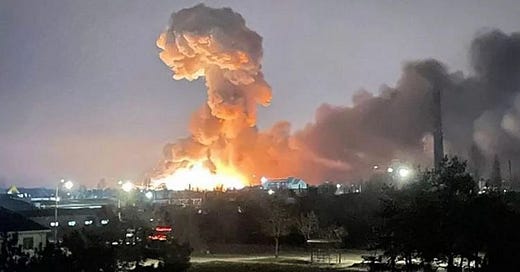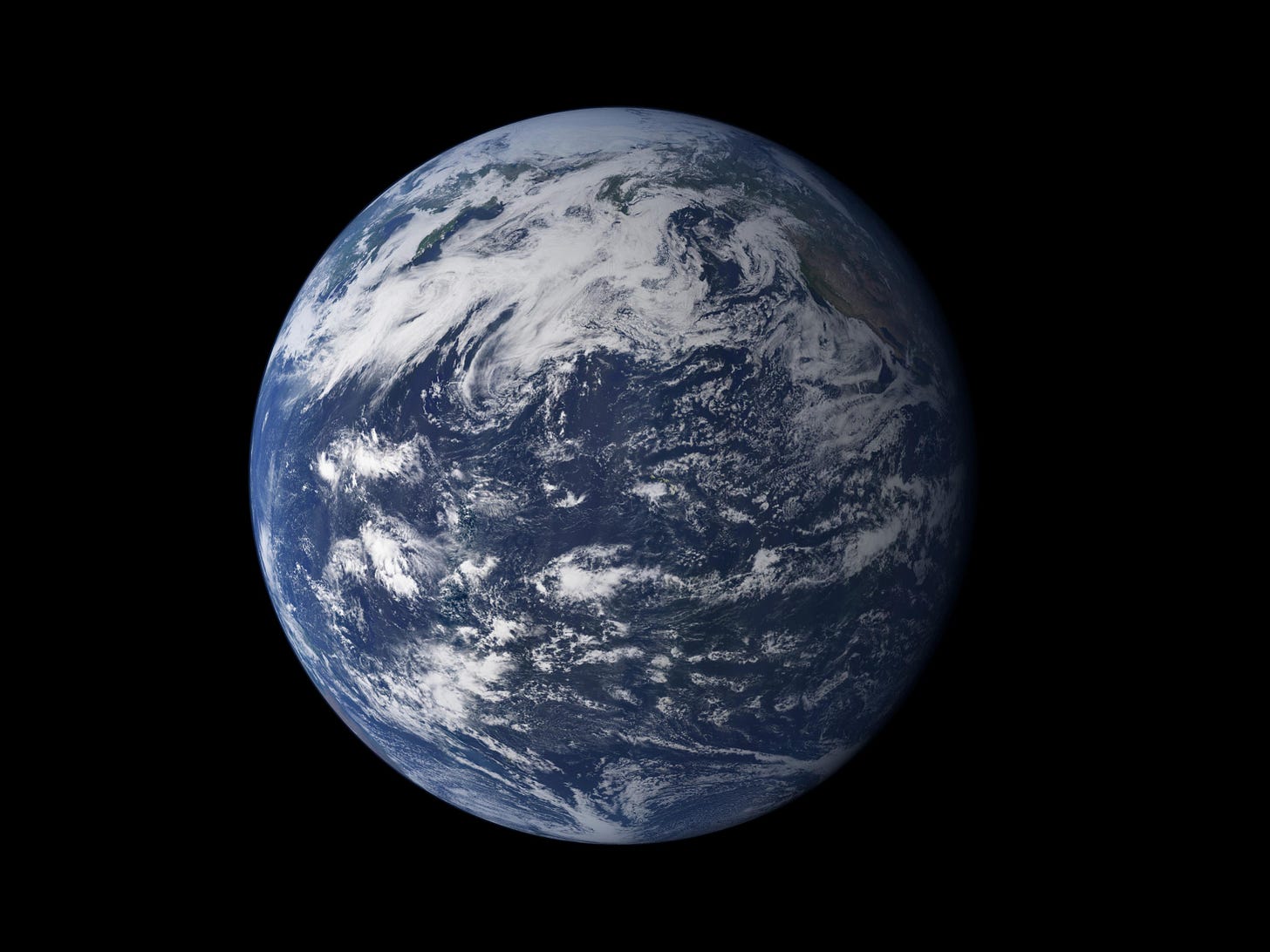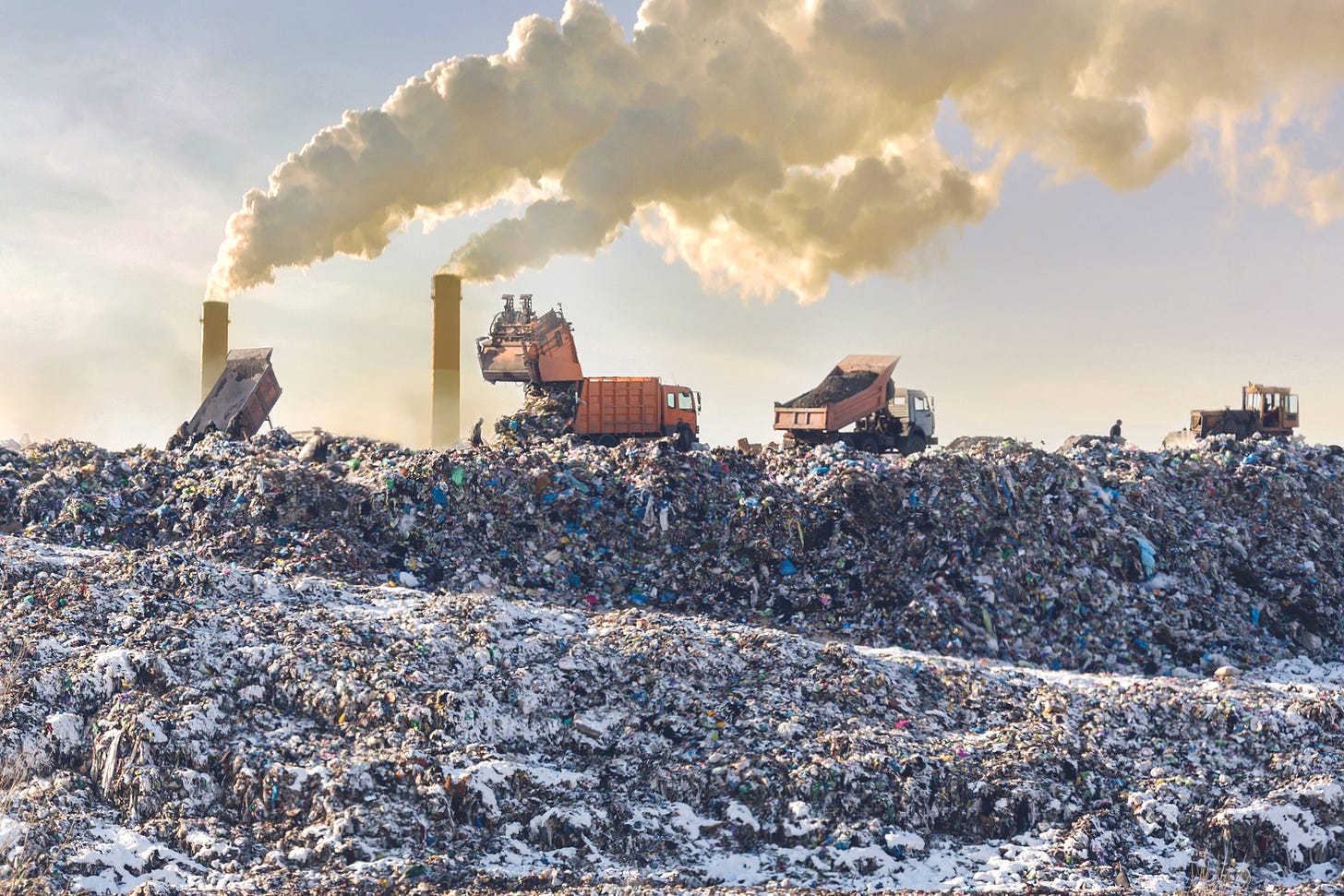Here Be Dragons, Part 3
2/3/22 – A Resource for understanding the Planetary Boundaries, continued
Hello everyone:
I want to first note two bits of existential news: Vladimir Putin’s grotesque decision to invade Ukraine, with a vague threat of nuclear warfare, and the new IPCC report on the severe threats from unchecked climate change to ecosystems, biodiversity, and human communities.
Here be dragons, indeed.
I’m sure Putin considers himself a dragon in a world of flammable peasants, but he’s merely a very successful snake. With support from democratic states and a bit of luck Ukraine may yet prove to be too large a prey to swallow whole, and he’ll choke on it. The nuclear saber-rattling is, as Noah Kim of Mother Jones put it, likely “just hot air from one of the largest balloons on the international stage.”
The IPCC report, though, “reads even more like a Mad Max script than previous entries,” says Kim. UN Secretary-General Antonio Guterres described the report as “an atlas of human suffering.” An atlas of human suffering: that also sounds like today’s map of Ukraine and Russia. I’ll have much more to say about the IPCC’s view of the world to come, but for now here are two comprehensive articles on the report from the Times and the AP, and a direct link to the IPCC report itself.
Please remember to scroll past the end of the essay to read this week’s curated Anthropocene news.
Now on to this week’s writing:
Two weeks ago I introduced and put into context the Planetary Boundaries concept from the Stockholm Resiliency Centre (SRC). Last week I began my resource for you to go a little deeper into it. I provided an introduction, and offered up my assessment of the two core boundaries (Climate and Biodiversity) and a third, Habitat Destruction/Land-Use. This week I’ll provide assessments for the next three boundaries: Ocean Acidification, Novel Entities, and Excess Fertilizer Use.
THE BOUNDARIES, continued…
Ocean Acidification is the dark mirror of Climate Change. What we’re doing to the skies we’re doing to the seas to a greater extent and with more real harm. All of our atmospheric methane and CO2 are increasing the greenhouse effect, yes, but the sky isn’t a habitat like the ocean (a vast array of habitats, really), where acidification by carbonic acid is beginning to undermine the entire food chain. The oceans have absorbed about 25% of our industrial emissions and are now 30% more acidic than they have been since humans first walked the Earth. The rate of acidification, according to the International Programme on the State of the Oceans (IPSO), is “unparalleled in at least the last 300 million years.” If left unchecked, by the end of this century this rapid acidification will turn the oceans 150% more acidic than pre-industrial levels.
I wrote about acidification at some length back in May/June 2021 in the second part of a two-part series called Looking Into the Abyss. Please check it out if you’re a new reader (first part here). But I’ll say now what I said then, which is that even in the face of so many other threats to stability in the planet’s systems I am particularly unnerved by the prospects of Earth’s oceans pushed toward the red end of the pH test. This is an ocean planet, after all.
And as I’ve written, this ocean planet has seen catastrophic acidification before:
“The terrifying reality of ocean acidification has only fully dawned on the scientific community in the last decade or so,” writes Peter Brannen in The Ends of the World, his book on previous mass extinctions: “Even more so than global warming, ocean acidification is what people who understand the fossil record, and who think about the future of the oceans, are most distressed by.”
To put a finer point on that distress, one estimate suggests we’re injecting CO2 into the atmosphere about ten times faster than the rate of the end-Permian event, the worst mass extinction in Earth history, when more than 85% of ocean species went extinct. Again, we’re nowhere near repeating that extinction, but if the rate of acidification is greater, than the prospect of unchecked acidification-related extinctions becomes greater too.
The acidity of the oceans matters to all life on Earth, including us, though that’s a concept very few of us have ever considered. Increasingly acidic waters reduce levels of the calcium carbonate necessary for the foundations of ocean life – plankton, corals, shellfish, and more – to build their shells and skeletons. As the foundations erode, so too will the already-stressed upper levels of the food chain, from fish to whales. As ocean life diminishes, so does coastal life, and the impacts ripple inland and upstream. Three billion people rely on food from the ocean.
About 99% of the planet’s volume of living space is in the oceans. I write here often that the biodiversity crisis – the cumulative threats to plants, animals, etc. – is just as important as the climate crisis. Ocean acidification is the nexus where the two crises meet. The primary threats (acidification, warming, and deoxygenation) to ocean ecosystems are all due to our rapid heating of the planet with greenhouse gases.
The first good news, then, is that if we can get a handle on CO2 emissions, then we’re getting a handle on long-term ocean acidification. It won’t be a quick turnaround, but we can and must pull back from the brink. Thus, there is no more momentous decision that human civilization can make for life on this planet than to eliminate the use of fossil fuels.
The other good news is that ocean acidification is still showing green in the Planetary Boundaries image. Without the near-term miracle of immediate action on climate change, though, it’s headed for yellow and orange.
There are ideas for actively drawing down acidity in the oceans as well, and the one that got my attention – marine permaculture – I wrote about at the end of the Looking Into the Abyss series. Take a look. In the meantime, here is a good acidification explainer article from NOAA, and another one from the Smithsonian.
Anthropogenic Chemicals, Plastics, Radioactive Compounds, Antibiotics, Pharmaceuticals, and other Pollutants (or Novel Entities per the SRC) is a long title for a much, much longer list of industrial products that are perhaps best described as bullets in an ecocidal war. Some, like pesticides and herbicides and poisons, were meant as bullets; the rest, numbering in the hundreds of thousands, were made for short-term human purpose and corporate profit heedless of their long-term environmental harm.
That manufactured harm continues today, scarcely regulated or limited by government or common sense. In many ways the harm is increasing, particularly as it relates to plastics. It’s best not to think of plastics as objects but instead as toxic chemicals in hardened form, like ice cubes made of pesticide. They may not be toxic in your hands, like the presumably inert plastic keyboard beneath the fingers typing this sentence, but they will be toxic once they leave your hands and end up in a landfill or incinerator. And they were toxic in nearly every step before they reached your hands, from the drilling platform to the refinery to the chemical manufacturer – all of which have huge carbon footprints and a terrible history of making workers sick and turning ecosystems into wastelands. And the reality, despite the cute little recycling symbols, is that nearly all plastics are single-use.
Simply put, there is no place on Earth uncontaminated by plastics, there are no effective regulations or limits on plastic production, and there is no real liability or responsibility imposed upon an industry that is actively harming human life and corrupting the natural systems of the planet. From ocean microbes to mother’s milk to raindrops, microplastics have infiltrated every dimension of life on Earth, and in doing so have completed a contamination of the biosphere by human production of artificial materials that grossly interfere with the production and development of life. If that seems a bit dramatic, remember that the mass of plastic production is around 370 million metric tons per year, roughly the mass of 2/3 of the human population.
Radioactive waste sites will persist as hazards for thousands of years. Pharmaceuticals and antibiotics pass through our bodies and our livestock in vast quantities and end up altering the biochemistry of species from soil microbes to birds to fish. Lead and other heavy metals lurk generation after generation in urban and industrial sites. Genetically modified organisms alter the relationships between species. PFAS and other persistent organic compounds, which accumulate in the environment because they don’t break down, are reducing fertility and causing genetic damage in species around the world. Population decline in many species is directly related to all of these haphazardly manufactured and distributed substances.
There are about 350,000 different anthropogenic chemicals and other toxins on the global market. For ecologists, these hazards are hiding in plain sight, contaminating so much of the natural world in random concentrations and in random combination with each other that it’s difficult to map their impact in precise ways. How do you parse and quantify the impacts of antibiotics, PFAS, mercury, microplastics, and antifreeze on fish in an urban stream? The work is being done, but it’s like standing in a spreading wildfire and trying to sort out sparks by their shade of orange.
Our use of all these substances needs to be reduced to the greatest possible extent, and the primary solution here is to completely reframe how we allow these substances to be created and distributed. In the midst of the Anthropocene, it’s long past time to regulate these substances according to the precautionary principle, which was defined by the Wingspread Consensus this way:
When an activity raises threats of harm to human health or the environment, precautionary measures should be taken even if some cause and effect relationships are not fully established scientifically. In this context the proponent of an activity, rather than the public, should bear the burden of proof.
Why is the burden of proof still on us to prove our cancers and hypothyroidism and fertility loss and chronic fatigue and immune disorders were derived from the swamp of chemicals produced by an industry which poisons life for a profit? Why does government provide them that right without providing us with an equal or greater right to clean air, clean water, and a healthy environment?
The good news: As I write this, talks have begun for a global plastics treaty. Here’s a summary from the Times:
The agreement commits nations to work on a broad and legally binding treaty that would not only aim to improve recycling and clean up the world’s plastic waste, but would encompass curbs on plastics production itself. That could put measures like a ban on single-use plastics, a major driver of waste, on the table.
It’s a good start.
Excess Fertilizer Use (Biogeochemical Flows per the SRC) is a story of two Earth elements, nitrogen (N) and phosphorus (P). Each is a biogeochemical, i.e. an element found in the physical Earth which is also fundamentally necessary for life. (Nitrogen is the foundation for all proteins, while phosphorus builds the scaffolding of DNA, cell membranes, and skeletons.) Each, along with carbon, has its own slow planetary cycle now radically disrupted by intensive human manufacturing and agriculture. The disruption occurs primarily in the production and application of fertilizer. The “biogeochemical flows” the SRC refers to is the excess flow, like a tap left running in the sink, of P and N in synthetic fertilizers from farms into soil, stream, sea, and sky.
Just as we blew up the carbon cycle by extracting millions of years of stored hydrocarbons and burning them in a couple centuries, we now convert more atmospheric nitrogen than all natural processes (by microbes/plants and lightning) combined. Through the Haber-Bosch process, we combine nitrogen in the air with hydrogen in methane to produce ammonia (NH3). The ammonia is further processed to create ammonium nitrate and urea. All of this has an immense carbon footprint. Ammonia is the second-most commonly produced chemical in the world, and its production accounts for 1-2% of global CO2 emissions. (Agriculture overall is the second-largest contributor to climate change.)
As an excellent explainer article at the MIT Climate Portal lays out, all this nitrogen production is immensely inefficient and harmful:
Crops only take up, on average, about half of the nitrogen they get from fertilizers. Much of the applied fertilizer runs off into waterways, or gets broken down by microbes in the soil, releasing the potent greenhouse gas nitrous oxide into the atmosphere. Although nitrous oxide accounts for only a small fraction of worldwide greenhouse gas emissions, pound for pound, nitrous oxide warms the planet 300 times as much as carbon dioxide.
The nitrogen rained out of soil into waterways and coastlines becomes nutrient pollution. It’s natural, but it’s way out of balance. It accumulates and, along with the excess phosphorus flowing out unused from the same synthetic fertilizers, transforms aquatic ecosystems into dead zones. (The die-offs result from depletion of oxygen as bacteria consume the blooms of algae that grow in response to the excess of nutrients.) We’re perhaps most familiar with the massive dead zone in the Gulf of Mexico caused by fertilizer transported in rivers from midwestern farms, but there are several hundred dead zones around the world’s coastlines. The World Resources Institute has an excellent interactive map of those dead zones you should check out; here’s a snapshot.
Phosphorus is mined rather than artificially extracted from the air. And like many mined substances in the Anthropocene, there are debates about how much we have left. Which makes our inefficient and excessive use of it all the weirder. (Not as weird, though, as the ghoulish story of Great Britain, spending much of the 19th century scavenging human skeletons out of battlefields, catacombs, and graveyards around Europe and beyond to bring home to be ground into bone meal for agricultural phosphorus. Along with animal remains, this trade amounted to millions of tons of bones worth millions of dollars. Read all about it in this astonishing article.)
The story of phosphorus is what this great Atlantic article describes as “a classic natural-resource parable”:
Humans strain against some kind of scarcity for centuries, then finally find a way to overcome it. We extract more and more of what we need—often in the name of improving the human condition, sometimes transforming society through celebrated revolutions. But eventually, and usually too late, we discover the cost of overextraction. And the cost of breaking the phosphorus cycle is not just looming scarcity, but also rampant pollution.
The solutions for this wildly exceeded planetary boundary mostly revolve around fixing the multiple problems with modern industrial agriculture. We need to stop applying so much synthetic fertilizer, replace synthetic fertilizers where possible with natural ones (e.g. compost and manure), recycle phosphorus, prevent soil erosion and agricultural runoff, eat a more plant-based diet, reduce food waste along the entire line from farm to fork, and reduce population.
To be continued…
This topic is a long haul. Thanks for sticking with me.
In curated Anthropocene news:
Reining in the chemical industry to reduce harms to climate, biodiversity, and human health: an op-ed from The Revelator.
The wonders of peat: Here’s an excellent illustrated/animated explainer article about peatlands and their ability to sequester carbon. The bottom line is we’d better be protecting and restoring as much peatland as much and as quickly as possible.
Want to measure likely sea level rise in your area of the U.S.? Check out the new mapping tool from NASA and look at their predictions decade by decade until the year 2150.
Welcome to the new age of fire: “Spreading like Wildfire: The Rising Threat of Extraordinary Landscape Fires,” is a new U.N. Environment Program report.
The surprisingly busy quest for airborne wind power, i.e. tethered kites or gliders generating power more efficiently than standard ground-based turbines.










That peat info is so eye opening!